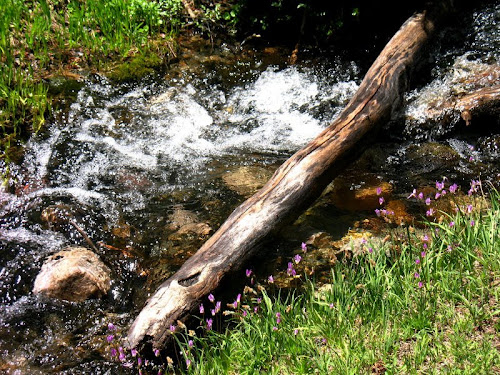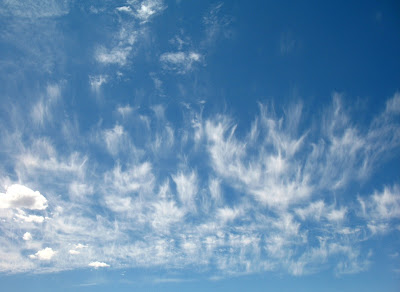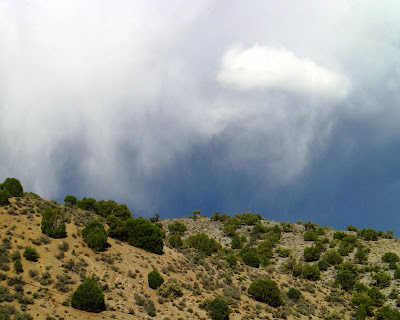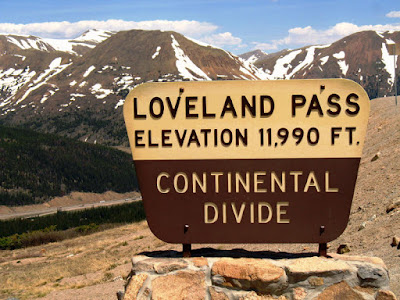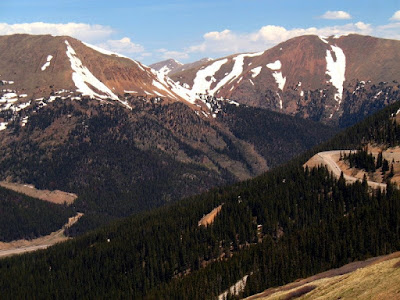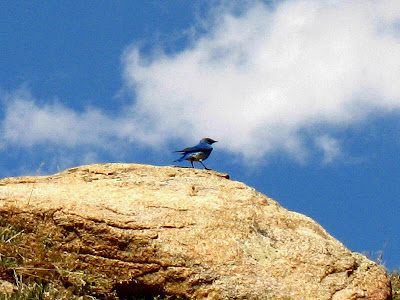I've been meaning to publish this one for awhile, but now's the time - it's summer,
people are in the field or
will be soon, and
Tuff Cookie ,
MJC Rocks, and
Hypocentre have both posted some
good lists of
things they have learned and
things that can go wrong while in the field. Some of the rules below will apply to non-desert-type field areas. Use some judgement.
1) Always walk in the shade if possible, even if that means tracking back and forth a little - and try to have your head in the shade in which you are walking.
2) Likewise, always sit in the shade if possible, even if that means scrunching yourself under a small cliff. Have as much of your body in the shade as possible.
3) You can create shade by placing a shirt over a bush and putting your head underneath the shirt. If you are sitting around waiting for someone to pick you up in the desert (like a helicopter or field partner), that small amount of shade is better than nothing.
4) In a similar vein, always wear a hat, a light-colored one is best. The hat will keep the sun off the top of your head, which will help keep you cool, cooler at least than without a hat. A baseball hat will keep the sun out of your eyes. A hat with a brim all the way around will keep the sun off your neck and ears, helping with possible sunburn problems.
5) Unless you really like a tan and are not very fair skinned, always wear sunscreen. I prefer sunscreen with a SPF of 30 to 50. SPF-15 sunscreen does almost nothing for me if I'm out all day long. (And even if you "like a tan," consider wearing sunscreen, anyway.)
6) When you come to a mine adit (or other dark, cool, or enclosed area), always throw a rock in before getting too close or going in. Rattlesnakes like to hide out and stay cool in mine adits. And,
as I've mentioned before, so do other wild animals like mountain lions.
7) Mine adits are great places to find shade. They are usually cooler than the heat of the mid-day desert sun, being at average, year-round ground temperature (that would be warmer than the outside air in the winter).
8) If you go into said mine adits, make sure with a light or the reflected light from your Brunton compass mirror that there aren't any shafts just inside the entrance. A shaft is a hole in the ground, into which you don't want to fall. If you have not had any training in underground workings and aren't with at least one other person (preferably two others),
DO NOT GO IN AT ALL.
Stay out,
stay alive. (Going in old workings and active underground mines has a whole other set of rules -
one rule is: two lights per person is minimum, and one light per person had better be a fully charged, REAL mine lamp, not a flashlight.)
9) If you have to walk out (from getting stuck or stranded in the desert), do so at night if at all possible. In fact, only walk out in daytime if you know exactly where you are going, what road or building or spring you are planning to get to, how long it will take to get there, and when you can expect a person to be coming along. Also, consider all of those things if you are walking out at night, while also considering how well and how safely you can traverse the ground in the dark.
10) Because deserts (and other countryside - anywhere) can also be cold, especially at night, and even in high summer - always carry waterproof matches.
11) Always know the countryside. Know where all the springs are, and know which ones have water this year. Know if any dry washes are likely to have water running in them. Know which so-called perennial streams or creeks might actually be dry.
12) In other words, always have a good topographic map with you. A GPS with a good, downloaded map might suffice, but batteries can die, and sometimes the satellites are unreachable (bottoms of some canyons) or their output might for some reason be inaccurate. A folded paper map will never run out of batteries and will never give you the wrong coordinates (unless you read it incorrectly).
13) If you are stuck or stranded and have a vehicle, stay with it. There are
only a very few occasions when leaving your vehicle to walk out is a good idea. Of course, you will have to make that decision in the field, hopefully not after you've become muddle-headed from lack of water, from heatstroke or heat exhaustion, or from exposure to the cold.
14) Always have plenty of water. If you have a vehicle, have it loaded with water. Five gallons in a vehicle is an absolute minimum, even when traveling on paved roads. In fact, when on any dirt road, the USFS and BLM
generally require you to have one axe, one shovel, and one gallon of water per vehicle. (And they may still be able to draft you for fire fighting, maybe.)
15) If you are out and about in the middle of nowhere (or maybe even somewhere), and you see a water trough or water tank - get in it. A great way to cool off. As mentioned
in the comments, it's probably a good idea to check for snakes first, especially in some areas, though I've never seen any in cattle troughs or tanks in the western and southwestern U.S. deserts (also, see note below about other areas).
16) Remember, almost any water (for drinking) will do in a real pinch, although particular water sources are best left for absolute last resorts. Carry some water purification pills (for the water, not you), and have a water purification system in your truck. As
Chuck notes below, NEVER drink radiator water that has antifreeze in it, which is most radiator water - that will kill you.
17) Don't ever, ever throw any water away, and use the absolute minimum necessary for things like washing dishes and hands, or brushing teeth. Absolute minimum. Absolute.
18) Don't drink beer while working in the desert (especially a hot desert, especially while camping out with possibly limited resources and a long walk out if your truck goes bad). Beer (etc.) is dehydrating. And don't whine (to me) about this rule. If you break this rule, go back to the rule about carrying lots of water, and triple the amount of water you need to carry in your truck.
19) If you are traveling about off-road in a vehicle, always have two spare tires. Head in as soon as the first one becomes flat. Don't wait for the second one to become flat! Carry some of that
awful tire goo. Know how to
change a tire, and have everything possible that you might need to use: cheater bar, WD40, handyman jack in case you are in a tight spot (do not use on rental car), and flares or orange triangles in case you are on the side of a major road. Have a tire pump in your truck - one that plugs into your cigarette lighter or attaches to your battery - in case you only have a relatively slow leak and don't want to use the awful tire goo.
20) Have any and all means necessary and possible for getting said vehicle
unstuck. Always carry a full roll of
duct tape.
21) Have a partner with you if at all possible, or at least be within walking distance of where people are or pass through routinely - routinely being at least 4 times per day. If you know or suspect that people - like ranchers, cowboys, sheepherders, or other geologists - pass through the area less than 4 times per day, then count that as zero people.
22) In other words, know the countryside you are working in and all the conditions.
23) Even before you become stranded, have a plan of what you are going to do, if. Where are you going to go? What will you do when you get there? Will there be someone there, or will someone come by in a vehicle? How long will you wait where you are after the helicopter pilot (or your field partner in a truck)
hasn't come to pick you up?
24) If you find yourself walking in circles while mapping, or if you find yourself not being able to decide which way to go next or what to do next - it is time to stop, whatever you are doing. Sit down. Sit down in the shade!
Do not sit down on a hot outcrop. Drink some water. If you have an ice chest with cold water from melting ice, put some on a scarf or hat or shirt, and put that on your head to cool yourself off. Maybe you are just walking in circles because it's late in the day and it's time to call it quits. Maybe you are walking in circles because you are in the very early stages of heat stroke or heat exhaustion. If you are young and sure of your condition, consider pouring some of the melted ice water over your head - that is a very fast way to cool off -- Disclaimer: this method may not be recommended by safety personnel because of potential shock or heart considerations.
25) Always carry a first-aid kit, even if only a small one. These days, a cell phone could be helpful, if you are in range. A satellite phone might be even better.
26) Always know the latest rules about what to do in case of a snakebite (the first-aid people change their minds about this one fairly often).
27) More about water - if you stop sweating, drink some water. Drink lots of water. Don't stop drinking water. Go into town and get a motel room with air conditioning. Your body will hardly cool you if the temperature is over 120 degrees F. Get on in to town!
28) Of course, some things might happen that you can't or haven't planned for - you will always have to improvise in those situations. Don't worry, there are a lot of resources out there, and you are a smart and resourceful person. And a little luck never hurts!
NOTE: in any desert (or field area) foreign to you, different rules might apply.
 Draw your own conclusions by reading the following links. At the time, the "blinding, deafening blast" was not a mystery. The "doom, doom, doom" scenario offered by many websites reminds me of dwarves in the The Mines of Moria per the Lord of the Rings.
Draw your own conclusions by reading the following links. At the time, the "blinding, deafening blast" was not a mystery. The "doom, doom, doom" scenario offered by many websites reminds me of dwarves in the The Mines of Moria per the Lord of the Rings.


